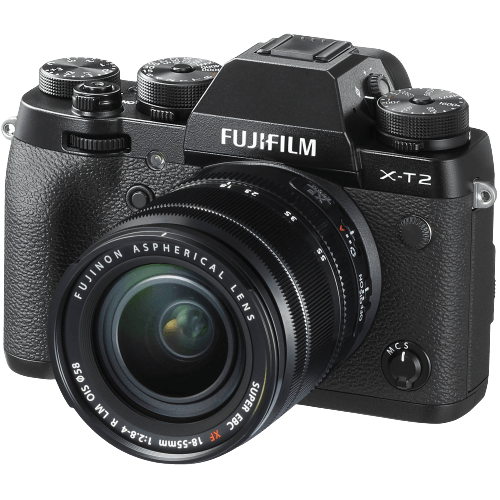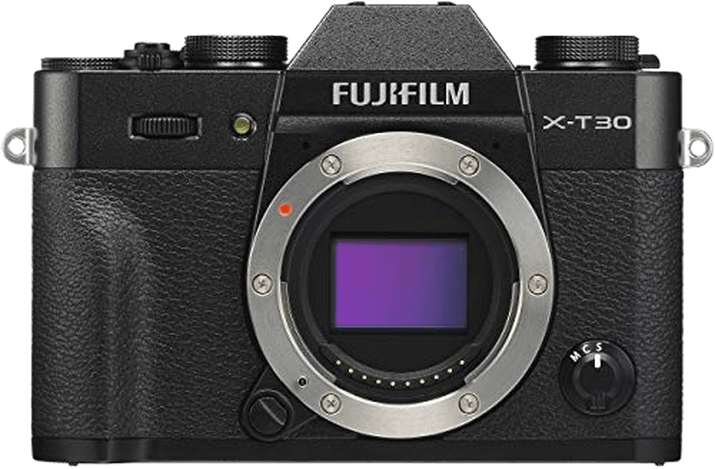Fujifilm X-T2 vs X-T30 Comparison
Fujifilm X-T2

Fujifilm X-T30

The Fujifilm X-T2 outperforms the X-T30 with a score of 68/100 compared to 65/100. Both cameras are mirrorless and share similar features. However, the X-T2, released in 2016, is a larger and heavier camera, measuring 133 x 92 x 49mm and weighing 1.12lbs, while the X-T30, released in 2019, is smaller and lighter at 118 x 83 x 47mm and 0.84lbs.
The X-T2’s higher score indicates it has better overall performance. However, the X-T30 holds an advantage in terms of its lower launch price of $899 compared to the X-T2’s $1599. Despite the X-T2’s better performance, the X-T30 offers a more budget-friendly option for those who prioritize affordability.
Taking into account the specifications and scores, the Fujifilm X-T2 is the superior camera, but the X-T30 provides a more cost-effective alternative for those seeking a lighter and more affordable option.
Fujifilm X-T2 vs X-T30 Overview and Optics
The Fujifilm X-T30 emerges as the winner in the optics comparison, scoring 67/100, while the Fujifilm X-T2 achieves a close score of 66/100. Both cameras share several specifications, including the CMOS sensor type, APS-C sensor size, Fujifilm X lens mount, and the absence of image stabilization.
The X-T30 outperforms the X-T2 with its 26-megapixel resolution, compared to the X-T2’s 24 megapixels, providing slightly more detail and clarity in images. Additionally, the X-T30 has a significantly faster shooting speed of 30 frames per second (fps), compared to the X-T2’s 14 fps. This advantage allows the X-T30 to capture fast-moving subjects and events more efficiently. The X-T30 also features the more advanced X-Processor 4, which contributes to its higher performance in terms of speed and image processing.
On the other hand, the X-T2 still holds its ground with its slightly lower score. It shares many of the essential features with the X-T30, such as sensor type, sensor size, and lens mount compatibility, ensuring that image quality remains competitive. However, its lower megapixel count and slower shooting speed may limit its appeal to those seeking the utmost in image detail and action-capturing capabilities.
In comparing the optics of the Fujifilm X-T2 and X-T30, it is evident that the X-T30 holds a slight advantage due to its higher resolution and faster shooting speed. However, the X-T2 remains a strong contender as it shares many key features with the X-T30. Ultimately, the choice between these two cameras depends on the specific needs and preferences of the photographer, as both models offer impressive performance and image quality.
Fujifilm X-T2 vs X-T30 Video Performance
The Fujifilm X-T30 outperforms the X-T2 in video capabilities, scoring 91/100, compared to the X-T2’s score of 83/100. Both cameras share some common features, including 4K video resolution, time-lapse functionality, and similar video dimensions. However, the X-T30 offers superior video quality and performance due to its higher maximum video dimensions and frame rate.
The X-T30 has a maximum video dimension of 4096 x 2160, while the X-T2’s maximum is 3840 x 2160. This difference in video dimensions provides the X-T30 with a wider and more detailed video output. Furthermore, the X-T30 can capture video at a much higher frame rate, reaching up to 120fps, compared to the X-T2’s 60fps. This increased frame rate allows for smoother video playback and improved slow-motion capabilities.
On the other hand, the X-T2 still offers respectable video quality with its 4K resolution and built-in time-lapse functionality. While it may not have the same level of detail or frame rate as the X-T30, it remains a viable option for those seeking a capable camera for video recording.
Considering the differences in video capabilities, the Fujifilm X-T30 is the superior choice for videographers and content creators who require high-quality video output and performance. Its higher maximum video dimensions and frame rate provide a noticeable advantage over the X-T2. However, the X-T2 remains a suitable option for those who do not require the additional features offered by the X-T30.
Fujifilm X-T2 vs X-T30 Features and Benefits
The Fujifilm X-T2 and Fujifilm X-T30 tie in features with a score of 70/100. Both cameras share several specifications, such as a 3-inch screen size, 1,040,000-dot screen resolution, flip screen, GPS, WIFI, and Bluetooth capabilities.
The X-T30 surpasses the X-T2 with its touchscreen feature, providing users with better functionality and ease of use. This advantage allows for quicker adjustments, focus control, and intuitive navigation through menus.
However, the X-T2 does not have any significant advantages over the X-T30 in terms of features. Both cameras have similar offerings, and the X-T2 does not outperform the X-T30 in any specific area.
Considering the feature comparison, the Fujifilm X-T30 is the better choice for users who value a touchscreen interface. The X-T2 does not offer any additional benefits that would make it a better option. Both cameras offer a range of useful features, but the X-T30’s touchscreen gives it a slight edge over its counterpart.
Fujifilm X-T2 vs X-T30 Storage and Battery
The Fujifilm X-T2 outperforms the X-T30 in storage and battery, scoring 68/100 compared to the X-T30’s 35/100. Both cameras accept SD, SDHC, and SDXC memory cards, and use the NP-W126S battery type. Additionally, both cameras offer USB charging.
The X-T2 has two memory card slots and is compatible with UHS-II cards, providing faster data transfer and greater storage capacity. This advantage allows photographers to capture more images without interruption. However, the X-T30 has a slightly longer battery life of 380 shots compared to the X-T2’s 340 shots, giving it an edge for extended shooting sessions.
Despite the longer battery life of the X-T30, the X-T2’s superior storage capabilities make it the better choice for photographers who prioritize storage and performance in their camera.
Fujifilm X-T2 vs X-T30 – Our Verdict
Are you still undecided about which camera is right for you? Have a look at these popular comparisons that feature the Fujifilm X-T2 or the Fujifilm X-T30:
